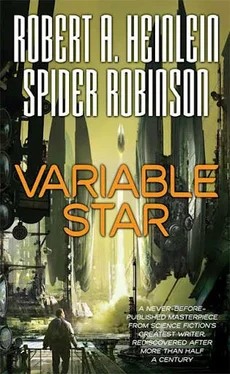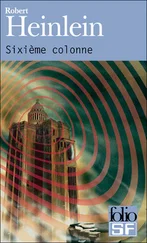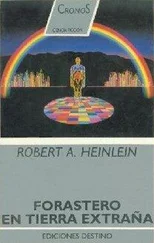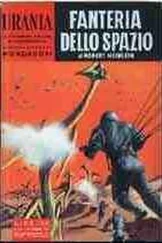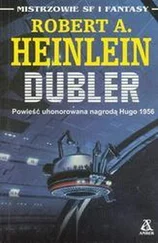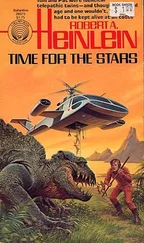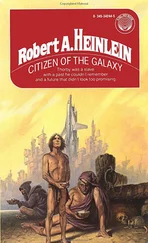But when I tried to find out just what that meant, and why it bothered him so badly, he changed the subject back to the star he was supposed to be telling me about: the one at the other end of our trajectory, Immega 714, AKA Peekaboo.
“In all the catalogs, gamma Boötes or HR5435 is commonly listed simply as ‘gamma Boo,’” he explained cheerily. “So when Claire Immega of the 44 Boötes colony sent back word that gamma Boo was not a single star but a binary, with a G2 companion, the formal name of the G2 became Immega 714 in her honor—but it took about fifteen seconds for the System’s media to name it Peekaboo. And when she added that its second planet looked extremely promising in terms of habitability, naturally that became Peekaboo Two. The name was just annoying enough to stick in a lot of minds, and the da Costa consortium became interested right away.”
But of course, you don’t start outfitting a starship on the basis of promises, however extreme. It wasn’t until Immega’s robot probes confirmed the good news that da Costa formed its partnership with Kang and began seriously planning our expedition. That took a while. Long enough that Immega herself did not live to learn just how spectacular her find had been.
Picture the geometry. 44 Boo, a variable star (eclipsing binary), lies a little more than forty-one light-years from Sol System. From there it’s another forty-three and change to the newly discovered Immega 714. The first colonists to settle on 44 Boo’s fourth satellite were a bit too busy surviving to stargaze a whole lot, but eventually two of them combined to produce Claire Immega. She became an astronomer, and soon discovered Peekaboo and Peekaboo Two. She was twenty-five before she had amassed sufficient clout to browbeat her fellow colonists into letting her divert what must have been scarce resources for ultrahighspeed probes. Even though these very tiny but very intelligent robots managed a very high fraction of c on their journey, it naturally had to take them well over forty-three years to make the trip, and then another forty-three years for their reports to make it back to 44 Boo at lightspeed.
From there, of course, the colonists’ telepaths were able to pass the data back to their siblings back at Sol System in zero time. But Claire Immega was over thirty years dead by then. So she never knew, at least not for sure, that the new planet she had given mankind was one of the best it had yet found within its reach.
“G type stars like gamma Boo are damned scarce within eighty light-years or so of Sol,” Matty told me, “and G2s that happen to have planets of the right mass orbiting within the zone that will permit liquid water to exist are less common than buttons on a snake. By now nearly all the really promising ones already have colonies either in place, or on the way there. And so far, nobody else has drawn the kind of jackpot Immega did.”
“It’s really that good?”
“Well, if you had your heart set on skiing, or ice fishing, I’m afraid you’re screwed. If you like bone-breaker gravity, you’ll hate the place. If you adore hostile environments, harsh conditions, scarcity, and surly natives, you’ll be bored silly. But if you can steel yourself to a world where your feet never hurt, food and energy are cheap, and everybody goes naked most of the time…”
That is happiness: to be dissolved into something complete, and great.
—Willa Cather
As soon as we got back to his luxury digs, he started bringing up Brasil Novo stats for me. Normally I’d rather read figures in printout than onscreen… but what he used for a monitor was an entire wall, bigger than any two walls in my place. So I sank back into an armchair so comfortable I kept murmuring thanks to it, sipped Matty’s excellent Scotch, and learned.
Brasil Novo is roughly the same size as Mars, but thanks to a smaller iron core, it is twelve percent less dense, giving it a surface gravity of .33 gee rather than Mars’s .38 gee. It lies more than 1.1 AU from its star—but Immega 714 is slightly brighter than Sol, so it seems normally bright in the sky for a sun, despite being ten percent farther away.
Here is how the planet stacks up beside Terra:
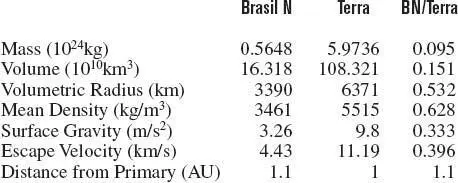
And here, for perspective, is a set of similar comparisons between Terra and another reasonably well-known planet of comparable gravity:
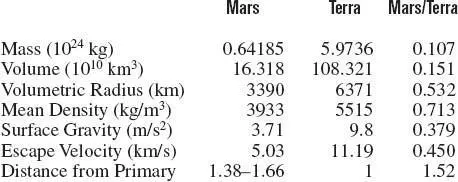
Brasil Novo comes complete with two moons, quite similar to those of Mars. For that reason, and for emotional/political reasons less susceptible to analysis, it had been rather illogically decided to name them, too, Phobos and Deimos.
“What difference does it make?” Matty asked when I raised the issue. “Nobody’s likely to confuse them in conversation with the ones we left eighty-five light-years behind. And very soon after arrival, everyone is going to become sharply aware that those two moons will have radically different effects than their namesakes, at least.”
Always happy to play straightman to a speaker who truly enjoys his subject. “Why’s that?”
“Because of something Mars lacks that Bravo has in great plenty.”
It took me a second to recognize “Bravo” as an Anglicized contraction of Brasil Novo. It was the first time I’d heard the shorthand, but it would by no means be the last. Within a year, even the two dozen or so real Brazilianos aboard would be using it. “What’s that?” I repeated.
He blinked at me. “Water. Teratons of water. The original Phobos and Deimos have tidal effects, but there’s not enough surface water on Mars to make them visible. Bravo is going to have very complicated tides, and I suspect its version of a king tide will be an emperor tide.”
I thought about it. “So, moist air, then.”
“It better be.”
The only reason it didn’t get tedious saying “Why is that?” to this man was that he always answered, and the answer was usually interesting. So I said it again.
“We expect, or at least hope, to live there. So we’ll probably want to breathe a lot. You have probably noticed that we are not carrying along with us in this bucket five hundred and fifty Mars-type low-pressure masks, plus several thousands more for replacements and the next several generations of offspring, nor are we spending any time drilling in them or trying to become acclimatized to them. If not, you’ve surely noticed that you don’t wear one when you’re working on the Upper Ag Deck.”
He paused, and did not say, “Think it through.”
Let’s see. Atmosphere breathable without assistance. But even less gravity than Mars or home. So to get Terra-standard pressure, there are only two possibilities: the atmosphere must be thicker, or it must be much higher in oxygen.
Okay, take Terra. Its surface gets that much pressure from lying under a troposphere about twelve kilometers high. Brasil Novo’s lower atmosphere would need to stand an unreasonable thirty-six klicks tall to yield that much pressure. So…
“The place is a tinderbox!” I exclaimed.
He shrugged carelessly. “The drier parts of it, yes. The air is a little over thirty percent oxygen. Here, take a look at this.” He gestured shamanically with his hand, working some virtual remote control only he could see, and the wall display changed to:
Atmospheric Composition

“Clearly it’s going to be a warm, moist planet, by human standards. A jungle world, very much like the Amazon Basin of Old Brasil back on Terra, I imagine. Its fauna seem to be fantastically better at photosynthesis than ours. But your guess is correct: that thirty percent oxygen is going to make for severe fire danger. I suspect that if an expedition to one of the drier regions were to be struck by lightning, the lucky ones would be those killed outright on the spot. I doubt the rest could outrun the flames.”
Читать дальше
